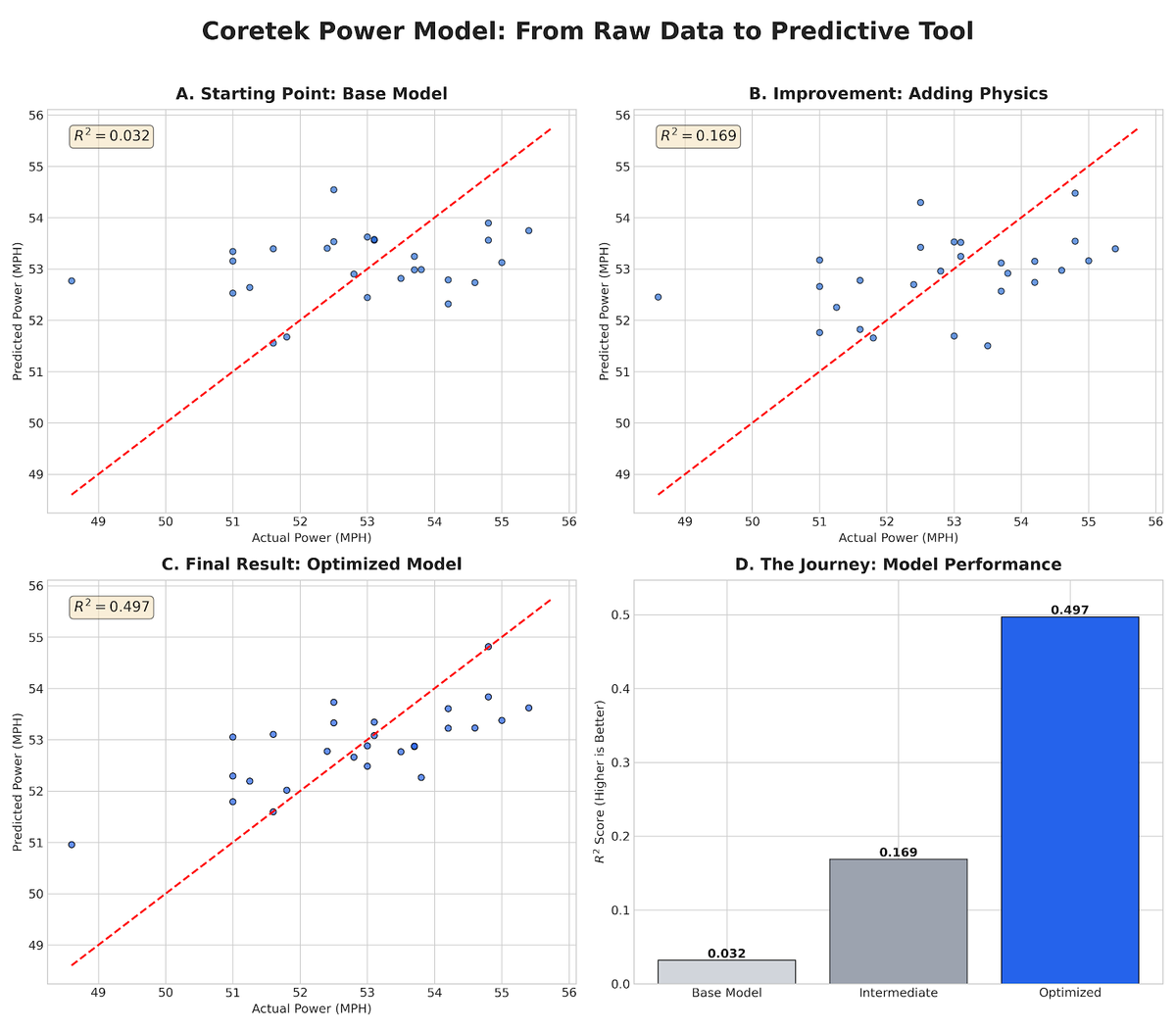
Data Driven Determination of Power and Spin from Physical Properties
|
|
|
Time to read 4 min
|
|
|
Time to read 4 min
Here at Coretek Pickleball, our mission has always been to use cutting-edge design and materials to build the best-performing paddles on the market. As a family-owned business right here in DFW, Texas, we're obsessed with the details. We don't just build paddles; we analyze every single element to understand what truly creates power, spin, and a paddle you can trust.
Recently, our R&D team achieved a major breakthrough in how we predict paddle performance. By moving beyond general characteristics and incorporating specific construction details—like the paddle's shape and surface texture—we've developed a new predictive model that is dramatically more accurate.
Today, we're pulling back the curtain to show you exactly what we've learned.
The goal was to see if adding specific manufacturing features to our data models would improve our ability to predict spin (RPM) and power (ball exit speed in MPH). The results weren't just an improvement; they were a transformation.
This is where we saw the most dramatic gains. By including features like the grit application process, our new model can explain the vast majority of what makes a paddle generate spin.
| Spin Model Version | R-squared | Mean Absolute Error (RPM) | Performance Gain |
|---|---|---|---|
| Previous Holistic Model | 0.5578 | 64.91 | (Baseline) |
| New Fully-Featured Model | 0.8715 | 35.19 | +56% R², -46% Error |
The power model also saw a significant boost in reliability, solidifying our ability to engineer for pure velocity.
| Power Model Version | R-squared | Mean Absolute Error (MPH) | Performance Gain |
|---|---|---|---|
| Previous Holistic Model | 0.4193 | 0.9663 | (Baseline) |
| New Fully-Featured Model | 0.4688 | 0.9142 | +12% R², -5% Error |
So, what are these "magic" features that unlocked such performance? Our analysis revealed the most influential factors our models use to make their predictions.
High spin comes from a combination of surface friction and the amount of time the ball stays on the paddle ("dwell time").
| Feature | Why It's a Top Predictor for Spin |
|---|---|
| Grit Type: Raw Texture/Peel Ply | This is the king of spin features. Modern, high-friction surfaces created by a raw carbon or peel-ply process provide the "bite" needed to grab the ball and generate massive rotation. Our model confirmed this is the single most important factor. |
| Core Thickness | This is the best indicator of dwell time. A thicker core (e.g., 16mm) cushions the ball at impact, keeping it on the paddle face longer. This gives that high-friction surface more time to do its job and impart spin. |
| Twistweight | This measures the paddle's stability. When you brush up the ball for a heavy topspin shot, a stable paddle (high twistweight) won't twist or wobble, ensuring all your energy goes directly into creating efficient, consistent spin. |
| mass_distribution_index | This quantifies how "head-heavy" a paddle is. A higher index means more mass is concentrated at the tip, which allows the paddle to maintain momentum through the brushing motion for more powerful spin. |
Power is all about mass, leverage, and efficient energy transfer.
| Feature | Why It's a Top Predictor for Power |
|---|---|
| rotational_mass | This advanced metric we engineered is the ultimate predictor of power. It doesn't just measure how heavy a paddle *feels* (Swingweight), but also *where* that mass is located. More mass further from your hand creates a sledgehammer effect for maximum impact power. |
| Swingweight | This is the classic measure of a paddle's mass in motion. It's a much better power predictor than simple static weight because it captures how heavy the paddle feels as you swing it. Higher swingweight equals more potential energy to transfer into the ball. |
| Shape: Extra-Elongated | An elongated shape acts like a longer lever, increasing the paddle's tip speed during a swing. It also moves the sweet spot further away from your hand. Our model confirmed this shape directly contributes to higher ball exit velocity. |
| Predicted_Spin | This shows how interconnected everything is. If our model predicts very high spin, it knows the paddle likely has a softer core to increase dwell time. The model has learned this design choice involves a slight trade-off in raw, absolute power and adjusts its power prediction for greater accuracy. |
This analysis confirms what we've always believed: a paddle's performance is a function of its entire design philosophy. There are no shortcuts. Power is born from dynamic mass, and spin is born from the perfect marriage of surface and stability.
Most importantly, our models now understand the trade-offs between these features. This comprehensive, data-driven insight gives our DFW-based design team an unparalleled advantage. It allows us to move beyond guesswork and engineer the next generation of high-performance paddles with precision, ensuring every Coretek paddle delivers on its promise.
This analysis details a major breakthrough in Coretek Pickleball's ability to predict paddle performance. By creating new "fully-featured" models that include specific construction details (like Grit Type and Shape), the team has dramatically improved accuracy compared to previous holistic models.
This data-driven insight gives the DFW-based Coretek R&D team an unparalleled advantage. By understanding the specific features that define performance and their trade-offs, they can engineer the next generation of high-performance paddles with scientific precision.
https://manus.im/share/file/dbdb27e4-d78d-420d-a4cb-2401830dbae6